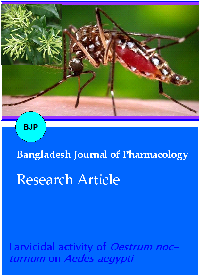Larvicidal activity of Cestrum nocturnum on Aedes aegypti
DOI:
https://doi.org/10.3329/bjp.v5i1.4714Keywords:
Aedes aegypti, Cestrum nocturnum, Dengue fever, LarvicidalAbstract
Aedes aegypti is a vector parasite of the Dengue. New method to control the population of this insect is necessary. In the present work we evaluated the potential of extract from Cestrum nocturnum as larvicide. Methanol extract outstand as highly active larvicide, achieving 100% larval mortality in 24 hours when tested in the concentration of 45 µg/mL (soxhlet) and 25 µg/mL (percolation). Any extract exhibiting significant larvicide activity was further fractioned and the fraction tested according to the WHO protocol. One fraction derived from methanol extract present remarkable LC100 at 12 µg/mL. LC50 of methanol extract and active fraction were found 14 µg/mL and 6 µg/mL respectively. These fractions will be submitted to further fractions aiming to identify the molecules responsible for the larvicide activity.
Downloads
2092
1269 Read
181
References
Finney DJ. Probit analysis. Cambridge (England), Cambridge University Press, 1971.
Fulmali PV, Walimbe A, Mahadev PV. Spread, establishment and prevalence of dengue vector Aedes aegypti (L.) in Konkan region, Maharashtra, India. Indian J Med Res. 2008; 127: 589-601.
Ghosh A, Chandra G. Biocontrol efficacy of Cestrum diurnum L. (Solanaceae: Solanales) against the larval forms of Anopheles stephensi. Nat Prod Res. 2006; 20: 371-79.
Ghosh A, Chowdhury N, Chandra G. Laboratory evaluation of phytosteroid compound of mature leaves of Day Jasmine (Solanaceae: Solanales) against larvae of Culex quinquefasciatus (Diptera: Culicidae) and nontarget organisms. Parasitol Res. 2008; 103: 271-77.
Kumar K, Chhabra M, Katyal R, Patnaik PK, Kukreti H, Rai A, Saxena VK, Mittal V, Lal S. Investigation of an outbreak of Chikungunya in Malegaon municipal areas of Nashik District, Maharashtra (India) and its control. J Vector Borne Dis. 2008; 45: 157-63.
Mimaki Y, Wantanabe K, Sakagami H, Sashida Y. Steroidal glycosides from the leaves of Cestrum nocturnum. J Nat Prod. 2002; 65: 1863-68.
Pelah D, Abramovich Z, Markus A, Wiesman Z. The use of commercial saponin from Quillaja saponaria bark as a natural larvicidal agent against Aedes aegypti and Culex pipiens. J Ethnopharmacol. 2002; 81: 407-09.
Sukumar K, Perich MJ, Boobar LR. Botanical derivatives in mosquito control: A review. J Am Mosq Control Assoc. 1991; 7: 210-37.
World Heath Organization, Instructions for determining the susceptibility or resistance of mosquito larvae to insecticides. WHO/VBC. 1981; 81: 807-962.

Additional Files
Published
How to Cite
Issue
Section
License
Authors who publish with this journal agree to the following terms:
- Authors retain copyright and grant the journal right of first publication with the work simultaneously licensed under a Creative Commons Attribution License that allows others to share the work with an acknowledgement of the work's authorship and initial publication in this journal.
- Authors are able to enter into separate, additional contractual arrangements for the non-exclusive distribution of the journal's published version of the work (e.g., post it to an institutional repository or publish it in a book), with an acknowledgement of its initial publication in this journal.
- Authors are permitted and encouraged to post their work online (e.g., in institutional repositories or on their website) prior to and during the submission process, as it can lead to productive exchanges, as well as earlier and greater citation of published work (See The Effect of Open Access).
